In this baking guide, we are going to delve deep into what is ganache (chocolate ganache) and uncover the secrets of this decadent, velvety-smooth chocolate delight. From distinguishing it from frosting and buttercream to choosing the finest chocolate and mastering the art of making it, this guide will answer all your questions.

Jump to:
- 💡 What is chocolate ganache?
- 💡 What is the difference between frosting and ganache?
- 💡 What is the difference between buttercream and ganache?
- 📝 What is ganache made of
- 💡Ganache ratios
- 👩🍳 How to make chocolate ganache
- 🎓 Troubleshooting ganache
- 👩🍳 How to store ganache
- ✨ Flavor variations
- 🎓 Expert tips
- ❓ Chocolate Ganache FAQs
- 🍰 How to use chocolate ganache
- 🧁 More frosting and filling recipes
- What is Ganache
💡 What is chocolate ganache?
So, what the heck is ganache? At its core, it is a simple yet exquisite mixture of just two ingredients; chocolate and cream. When you pour warm cream over chocolate, it creates a smooth and shiny substance that can serve as a filling, dip, spread, frosting, or topping!
Beyond these two basic ingredients, some recipes also calls for butter to make the texture even smoother, and salt, that is a must in my view to balance the sweetness of the ganache.
But more importantly, what does ganache taste like!? It’s got a flavor that is nothing short of heavenly! When made with high-quality chocolate, ganache offers a deep chocolate flavor and a touch of creaminess from the heavy cream that just melts in your mouth. The actual flavor profile of the ganache also depends on whether you are using milk chocolate, white chocolate, dark chocolate, or even the Instagram-famous pink ruby chocolate.
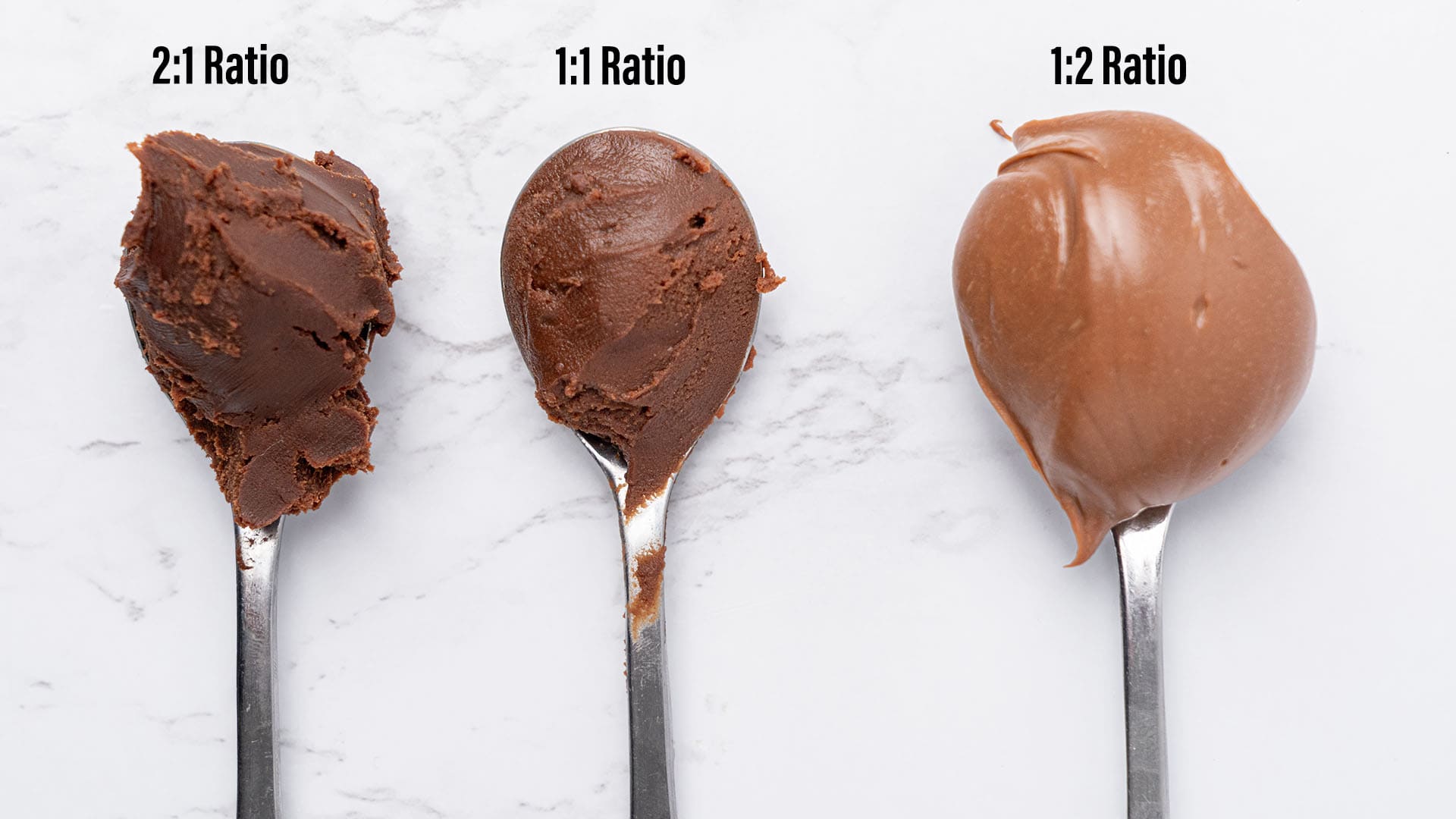
💡 What is the difference between frosting and ganache?
Some may classify ganache as frosting, but they have differences. Ganache is a chocolate and cream mixture known for its intense flavor and glossy texture. Frosting, on the other hand, is a sweet, creamy topping made from ingredients like butter, cream cheese, and powdered sugar that comes in various forms such as buttercream and cream cheese frosting.
Then what is ganache frosting? Basically, we just call it whipped chocolate ganache frosting when it’s whipped together with some extra heavy cream and gelatin to make it fluffy and pipeable. However, ganache frosting doesn't contain any butter.
💡 What is the difference between buttercream and ganache?
The key differences between buttercream and ganache are in their ingredients and texture. Buttercream is a sweet and creamy frosting made from butter and powdered sugar, ideal for decorating due to its ability to maintain its shape.
Whereas, ganache is a mixture of chocolate and heavy cream. Yet, ganache can also be used to pipe and decorate cupcakes and cakes as I explain in my whipped chocolate ganache frosting recipe.
📝 What is ganache made of

- Chocolate - It’s vital that you know what chocolate to use! Typically, crafted from semi-sweet chocolate (35% to 45% cacao) or, for a deeper flavor, bittersweet chocolate (60% cacao). However, you can also experiment with milk or white chocolate, though you will want to use a higher chocolate vs. cream ratio with those. Regardless of your choice, high-quality chocolate like Callebaut or Ghirardelli is the heart of ganache. Avoid low-quality chocolate chips or imitation chocolate at all costs.
- Heavy Whipping Cream - Use high-fat heavy whipping cream with a fat content of at least 36%. Low-fat cream will yield a thinner consistency, leaving you wondering if is ganache supposed to be runny. The answer is no! Check out this article to learn more about heavy cream.
- Salt - Technically, salt is an optional ingredient. However, a pinch of salt is necessary to balance the sweet chocolate flavor.
🛒 You’ll find detailed measurements for all Ingredients in the printable version of the Recipe Card at the bottom of this post
💡Ganache ratios
The perfect ganache recipe is all about the ratio of chocolate to cream. The proportion of these two ingredients significantly impacts the final texture and application. As a general rule, the more the chocolate the thicker the ganache will be, and the more the cream, the thinner the ganache will turn out.
Please note that the ratios below are primarily valid for semi-sweet and dark chocolate but if you are using a lower cocoa % milk chocolate, to achieve the same texture you will want to use more chocolate and less cream.
It is also important to highlight that these ratios are not set in stone and some recipes might call for different ratios especially if other ingredients such as butter or liqueur are also added to the recipe.
1:1 Ratio
For a versatile ganache that works well as a thick glaze over a cake or as a tart and cake filling, the most popular 1:1 ratio is perfect. This means using equal parts chocolate to cream just as I am explaining in my chocolate Passion fruit tart recipe. I use a 1:1 ratio to glaze on my chocolate ganache cake as well and add a very small amount of butter for some extra smoothness.
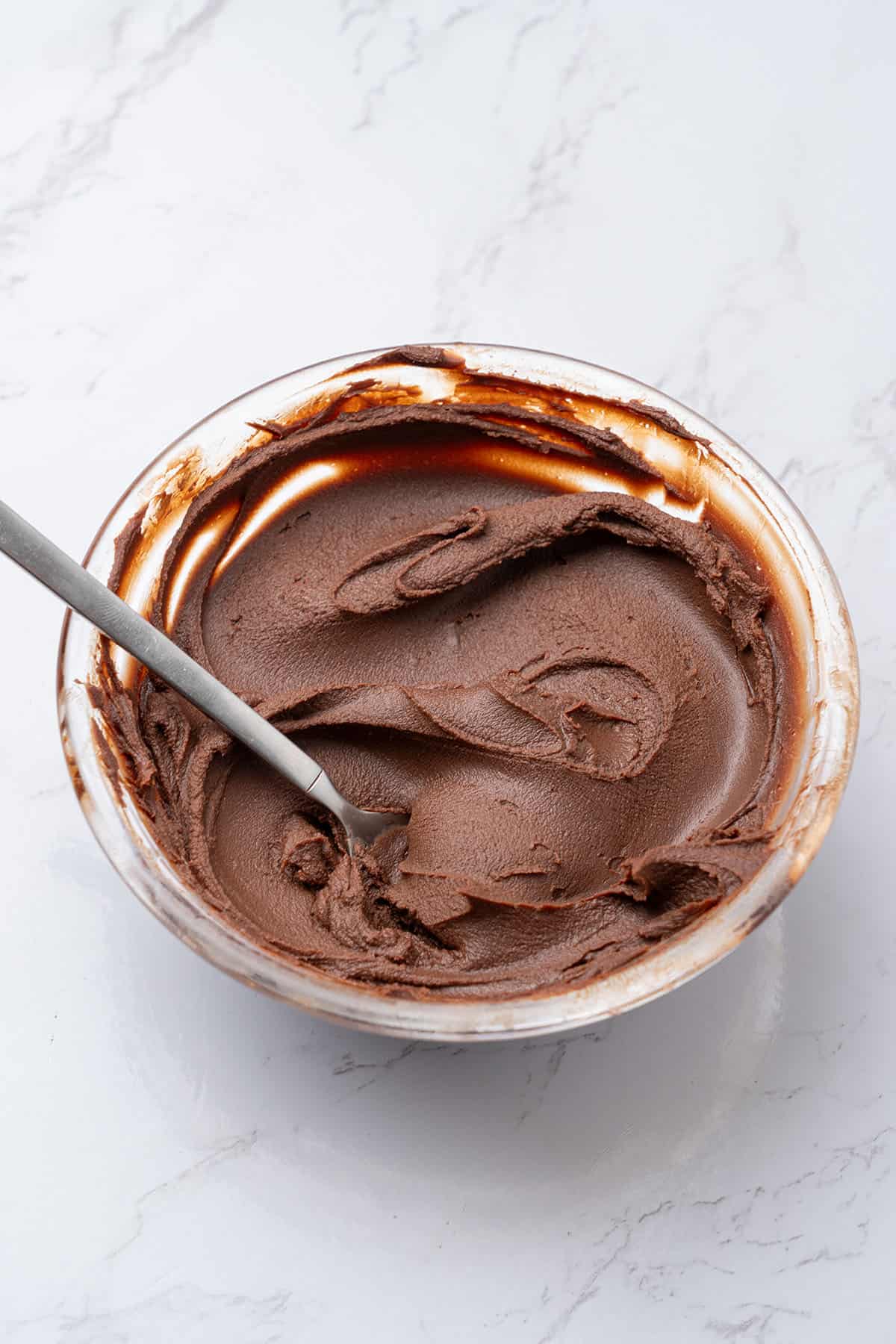
2:1 Ratio
If you need a thicker and fudgy ganache for making chocolate truffles or filling macarons, then the 2:1 ratio is the way to go. This means using twice as much chocolate as cream.
Tip: Make sure to semi-melt the chocolate in the microwave as the half the amount of hot cream might not be able to. full melt the chocolate.

1:2 Ratio
For a more pourable ganache to use for dipping fruit, use the 1:2 ratio. In this case, that means using just one part chocolate to two parts heavy cream.

Ratios for different types of chocolate
These ratios can vary based on the type of chocolate you choose. These are common ratios based on chocolate type:
- Dark Chocolate: The ratio is typically 1:1, which creates the consistency of classic ganache.
- Milk Chocolate: Milk chocolate contains less cocoa butter than dark chocolate, so it's best to use a ratio of 2:1.
- White Chocolate: White chocolate requires even more adjustments due to its lower cacao content. The ratio can vary by brand and be as high as 3:1.
👩🍳 How to make chocolate ganache
Learning how to make ganache right in your own kitchen is much easier than you might think!
Follow these easy steps:
- Begin by placing the finely chopped chocolate into a medium heat-proof bowl.
- Heat the heavy cream over medium heat just until it starts to gently simmer. It's crucial not to let it come to a rapid boil.
- Pour the warm heavy cream over the chopped chocolate. Then let it sit for 1 to 2 minutes to soften the chocolate.
- Use a rubber spatula to stir the chocolate and cream together until the mixture is smooth.
- You can use the ganache immediately as a drizzle. To use it as a glossy glaze, let it cool for 15 minutes before pouring it over your cake. To use the mixture to make truffles, let it chill in the fridge for about an hour, and for about 4 hours to use it as a pipeable frosting.
- Once the ganache has cooled, you can also use an electric mixer to whip it for about 4 minutes on medium-high speed to create a mousse-like whipped ganache frosting. However, for an even better texture check my whipped chocolate ganache recipe in which some part of the cream is added to the ganache without heating the cream up.
💡 Top Tip: When using a ratio where there is a greater amount of chocolate than cream, you need to gently semi-melt the chocolate in the microwave. The cream itself won't be able to fully melt the chocolate.
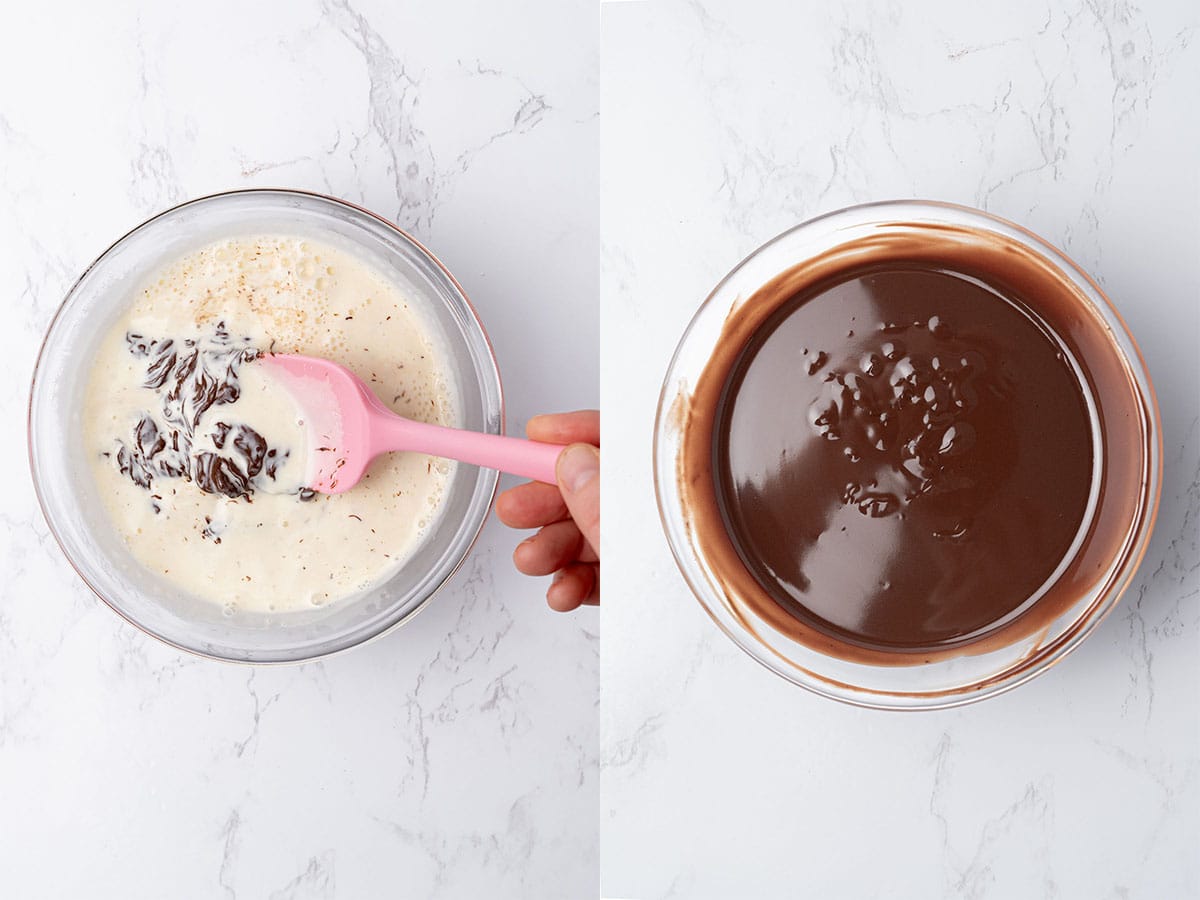
🎓 Troubleshooting ganache
1. Problem: Chocolate Isn't Melting
- Issue: What should ganache look like? Smooth and creamy. If you’ve got chunks of chocolate that just won’t melt then it's not quite right.
- Solution: This is why it’s really important to finely chop the chocolate into small pieces and make sure the heavy cream comes to a simmer. The best way to fix this problem is the double boiler method. Put the chocolate mixture into a heat-proof glass bowl and then set the bowl over a small saucepan filled with simmering water. Now, stir the ganache continuously until it becomes smooth.
2. Problem: Too Thin
- Issue: You’ve run into a problem if you’re asking yourself, should ganache be runny?
- Solution: Probably you used either a low-fat cream (less than 36% fat) or the chocolate vs. cream ratio was incorrect. If your ganache is too thin, try to chill in the fridge for a few hours. If it won´t set even after refrigerated, it will be hard to fix it however you can try adding melted chocolate into the ganache in small increments and hope that the additional melted chocolate will solidify back in the refrigerator.
3. Problem: Chocolate Seized
- Issue: When you run into seized chocolate you may think, should ganache be hard? Not really but the ganache should be thick enough. But not a solid mass of gritty chocolate.
- Solution: Chocolate seizes up when it comes into contact with water. But oddly enough more water is the solution! To fix seized chocolate, add 1 teaspoon of boiling water at a time and stir vigorously until the chocolate is smooth.
4. Problem: Greasy Texture
- Issue: Your ganache seems greasy and maybe even separated.
- Solution: Use a rubber spatula or spoon to combine the chocolate and warm cream. Even better to use an immersion blender but make sure not to create unnecessary bubbles in the ganache.
👩🍳 How to store ganache
To prevent the formation of a crust, always cover the surface of your ganache with a piece of plastic wrap before sealing your airtight container. This simple step will help preserve the ganache's texture and flavor. You can then store it in the refrigerator for up to 5 days or in the freezer for 3 months. Just let it thaw out before using it.
Can ganache be stored at room temperature? While it can sit at room temperature for a few hours, it's not advisable for long-term storage. The dairy in ganache can easily spoil just like it does in all food.
✨ Flavor variations
- Coffee: Infuse it with coffee flavor by heating the cream with some coffee beans or espresso grounds.
- Minty: Add a dash of mint extract or fresh mint leaves.
- Fruity: Incorporate some orange zest or lime zest. You could also mix in some ground freeze-dried fruit.
- Nutty: Mix in a bit of pecan, hazelnut, or peanut butter!
- Spices: Experiment with spices like cinnamon, cardamom, pumpkin pie spice, or chili powder.
- Liqueur: Blend in a little Grand Marnier, Chambord, or Amaretto to add an adult twist to your recipes.
- Vegan: You can replace the heavy cream with high-fat coconut cream at a 1:1 ratio to make vegan chocolate ganache.
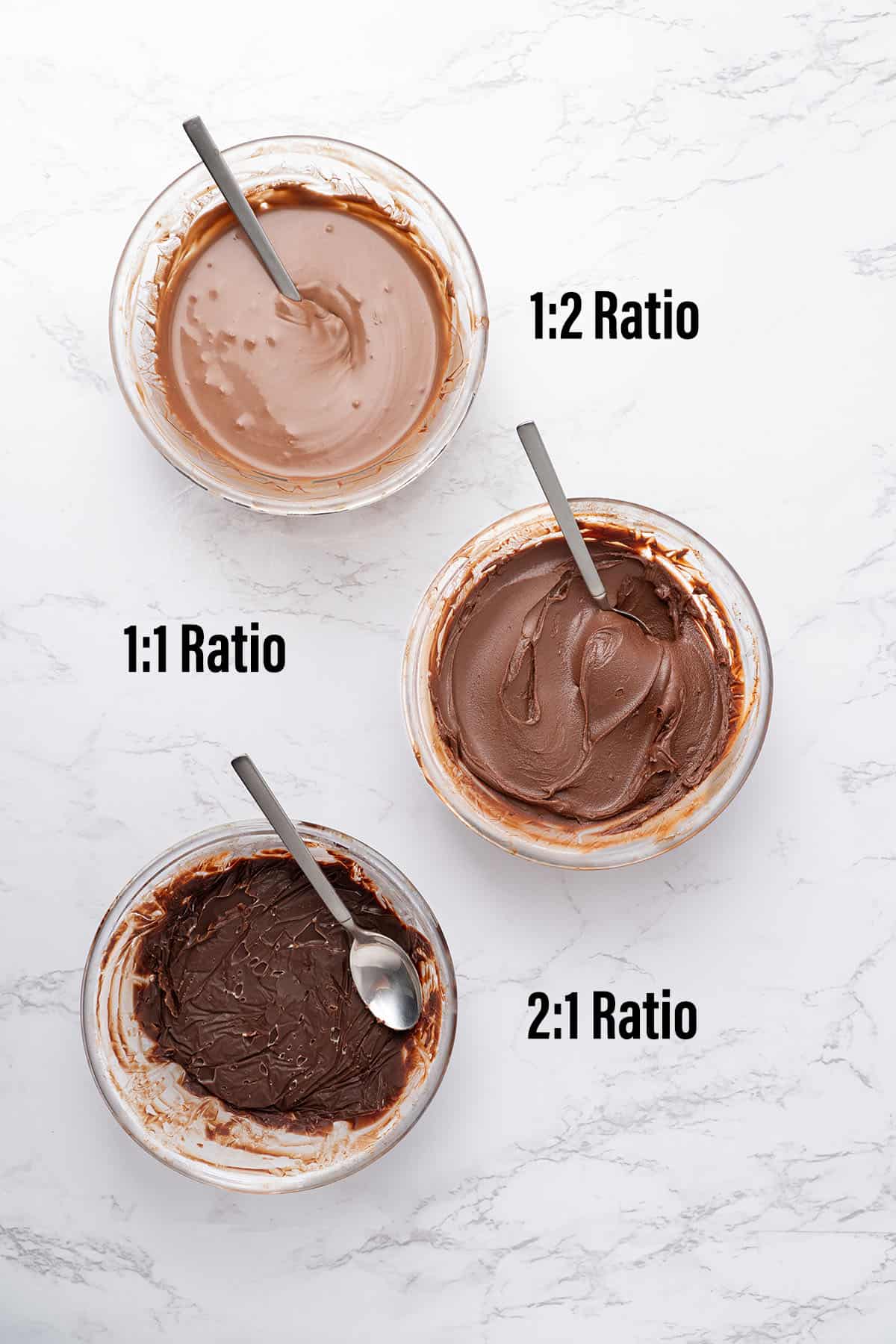
🎓 Expert tips
- Choose high-quality chocolate like Callebaut, Ghirardelli, or Lindt for the best taste and texture. Chocolate chips and imitation chocolate will not produce a good result and are better for making chocolate chip cookies.
- Use high-fat heavy cream with a fat content of at least 36%. Lower fat creams will result in a thinner consistency.
- If using chocolate bars, chop them into fine pieces before melting to ensure the chocolate blends smoothly.
- Understand the chocolate-to-cream ratios to achieve your desired consistency. It’s also important to consider ratios when you’re using different types of chocolate.
- Heat the cream until it begins to gently simmer. Avoid letting it come to a rapid boil.
- Don't forget a pinch of salt! It's essential to balance the sweetness and enhance the chocolate flavor.
- When using a ratio where there's more chocolate than cream, gently semi-melt the chocolate in the microwave. This helps the cream fully melt the chocolate.
- If you're melting chocolate in the microwave, use a plastic bowl. Chocolate can easily burn in a glass bowl.
❓ Chocolate Ganache FAQs
Yes! You can gently reheat it using a double boiler or by placing it in a heat-proof bowl over a pot of simmering water.
Yes, ganache thickens as it cools due to the solidification of fats from the chocolate and cream.
Yes, but the results will be runny and not ideal.
🍰 How to use chocolate ganache
Now, for the best part! What is ganache used for? With its creamy texture and rich chocolate flavor, you can add it to almost any sweet treat!
- Filling: Thinking, can ganache be used as a cake filling? Absolutely! It's not only perfect for chocolate cake but also for filling tart crust, oreo pie crust, pastries, and macarons.
- Coating: You can pour it over cakes for a glossy and decadent finish. So, what is chocolate ganache cake? This is it!
- Truffles: When chilled and firm, you can roll it into small balls and coat it to create truffles or homemade Ferrero Rocher.
- Sauce: You can use slightly warm ganache as a dipping sauce for fresh fruits, marshmallows, pretzels, or cinnamon twists. It's also a fantastic ice cream cake topping.
- Cupcake Frosting: Whip ganache until it's light and fluffy, then use it to frost my cinnamon cupcakes or vanilla muffins.
🧁 More frosting and filling recipes

What is Ganache
Equipment
- Digital scale
Ingredients
- 170 g (1 cups) Semi-sweet Chocolate good quality dark chocolate eg. Callebaut 811 Dark chocolate callets
- 170 g (¾ cups) Heavy cream 36% fat
US customary cup measurement is an indicative figure only. Measure the ingredients with a digital scale by weight (gram). Baking is art but also science which requires precision and accuracy.
Instructions
- Place the finely chopped chocolate in a medium heat-proof bowl.
- Bring the heavy cream to a simmer over medium heat. Do not let the cream come to a boil.
- Pour the warm heavy cream over the chopped chocolate in the bowl and let it sit for 3 to 4 minutes to soften the chocolate.
- Stir the chocolate and cream together with a rubber spatula until the chocolate is fully melted and smooth.
- The ganache is now ready for use. You can immediately use it as a drizzle. To use it as a glossy glaze, let it cool for 15 minutes before pouring it over your cake. If you plan to make truffles, chill it in the fridge for about an hour, and for pipeable frosting, refrigerate it for approximately 4 hours.
- Once the ganache has cooled, you can also make a mousse-like whipped ganache frosting by whipping it with an electric mixer for about 4 minutes on medium-high speed.
Notes
- Measure your ingredients with a Digital scale for accuracy.
- Good quality chocolate (eg. Callebaut) will make the best chocolate ganache.
- Use high fat content heavy cream (36%).
- Make sure you read my Expert tips and troubleshooting section above to maximize your success. A short recipe alone is not able to cover all the necessary details, and science behind baking.
- 170 grams dark chocolate
- 170 grams heavy cream
- 170 grams chocolate
- 85 grams heavy cream
- 85 grams chocolate
- 170 grams heavy cream
- Dark chocolate: Use the above ratios.
- Milk chocolate: It's best to go with a 1,5:1 or 2:1 ratio.
- White chocolate: A 1:2 ratio is ideal to create a very thin, pourable ganache. But to make it thicker the ratio is usually 3:1 or even 4:1 (chocolate to cream).




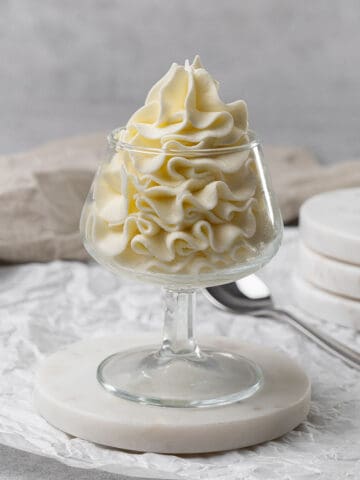





Sue
what ratio would you recommend for a cheesecake topping if desired outcome is a thick layer?
Katalin Nagy
1:1 probably a good place to start however really depends on your chocolate.